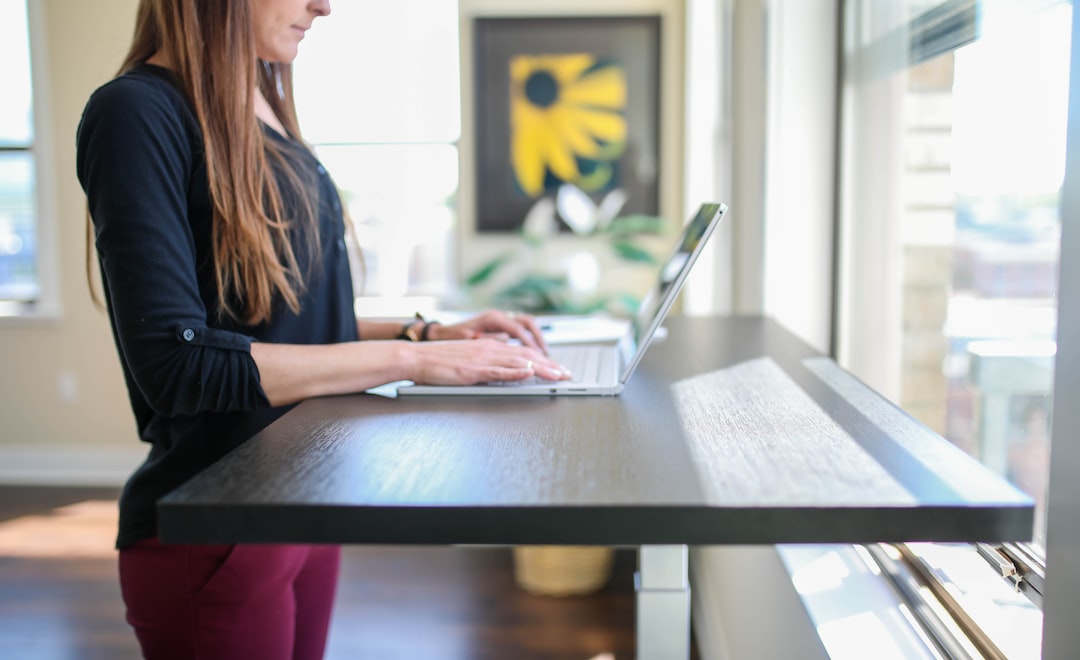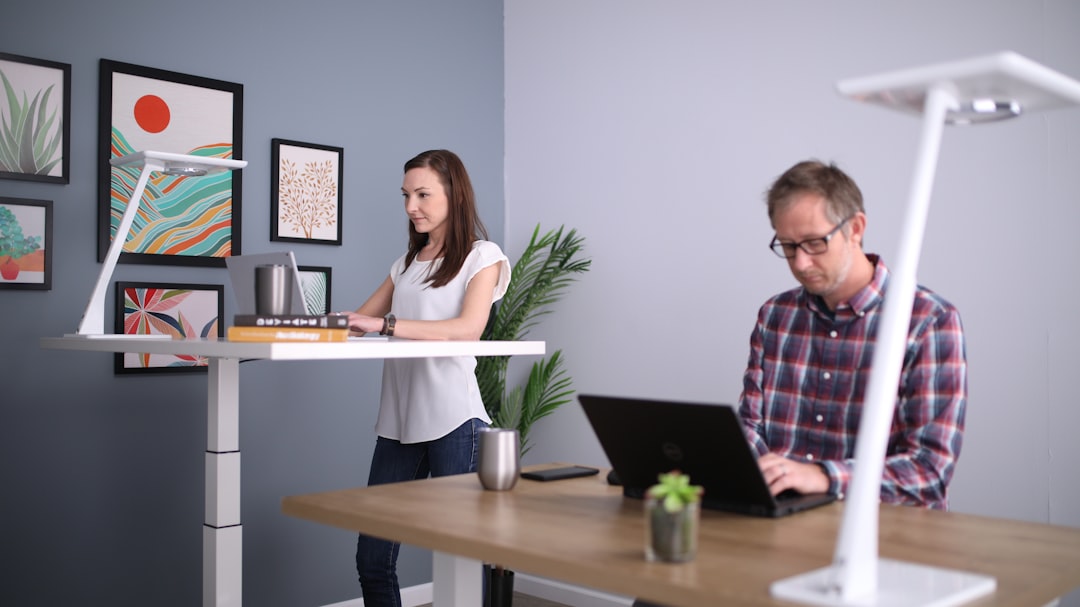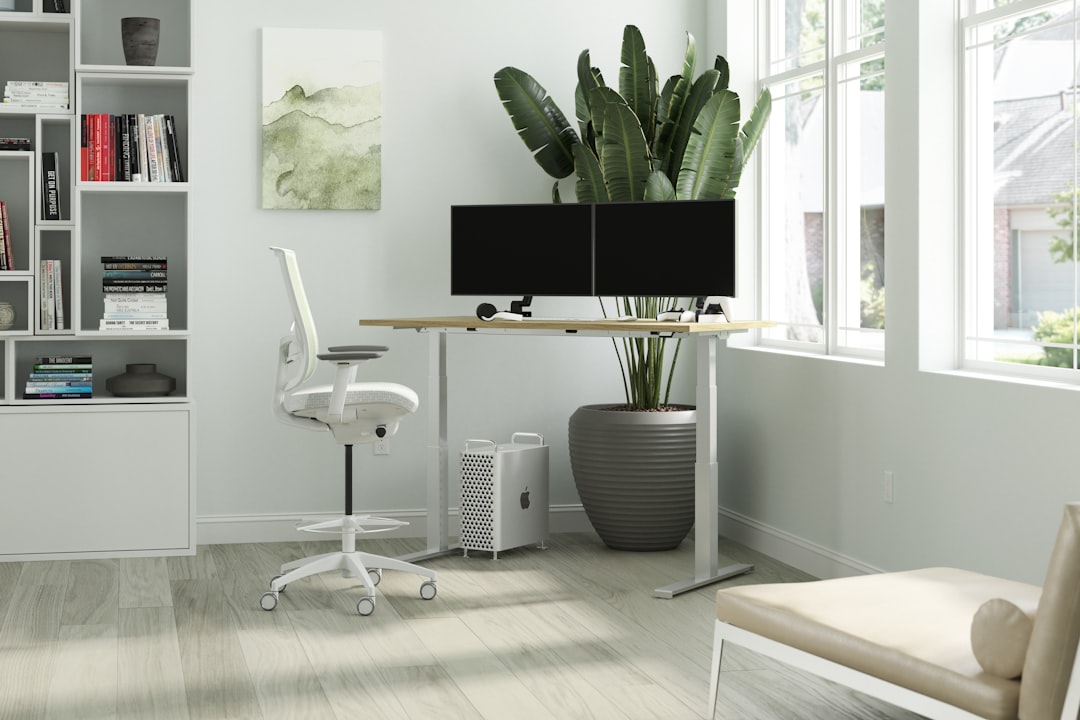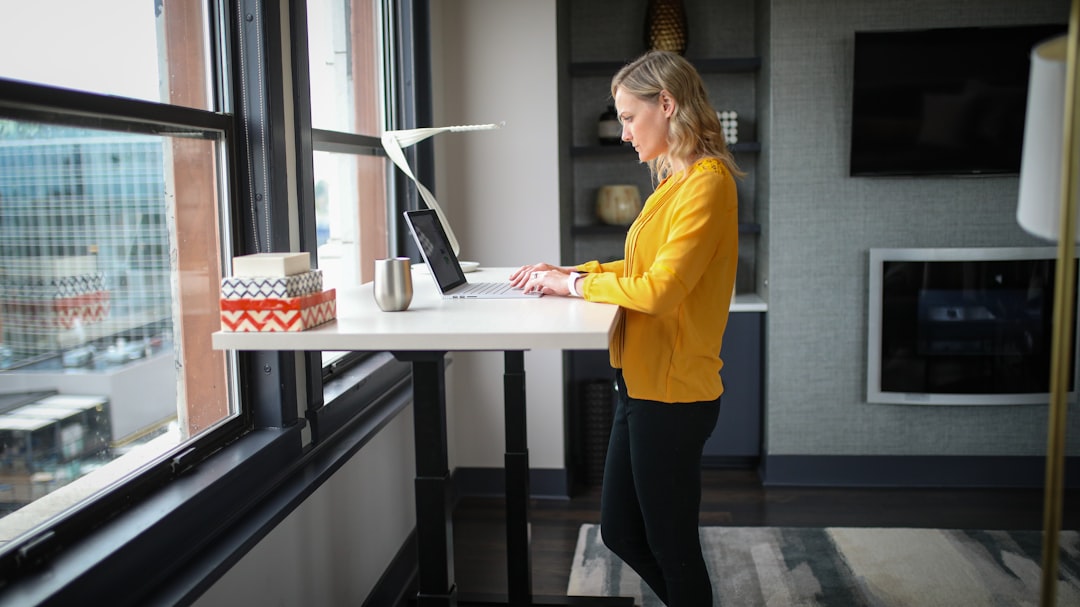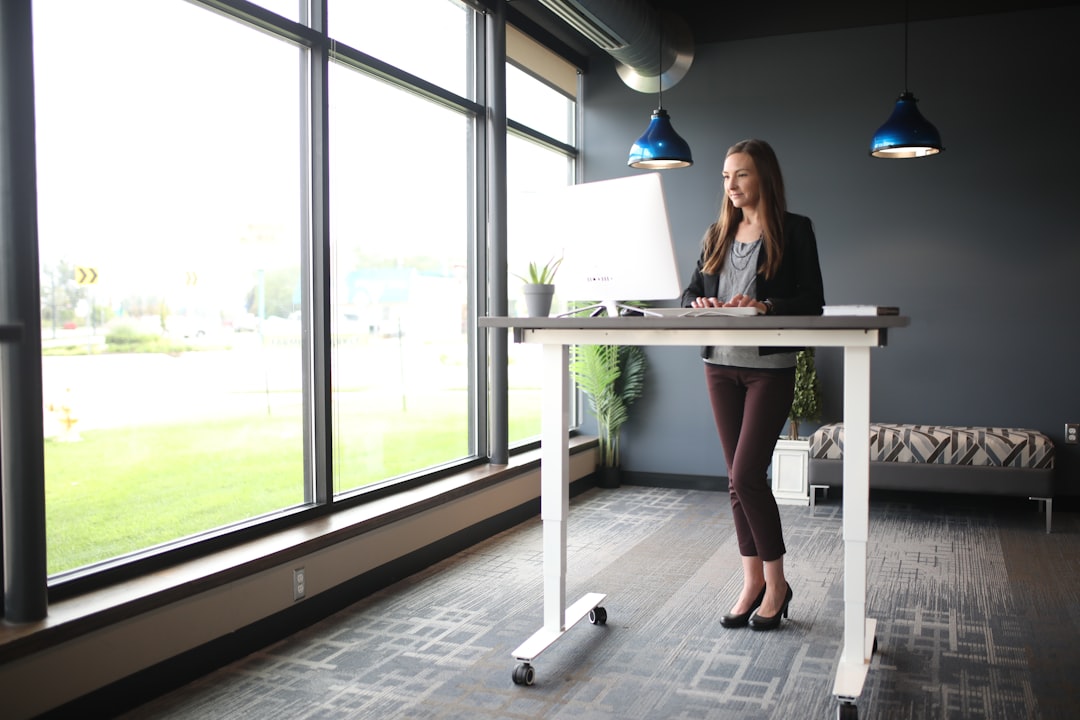Are you tired of sitting in the same position at your desk all day, every day? Do you feel lethargic and unmotivated to work? Then it’s time to switch to a DIY standing desk! Not only will it increase your productivity, but it will also improve your posture and overall health.
No longer will you have to struggle with a sore back or stiff hips from prolonged sitting. A standing desk provides you with the flexibility to move around and change positions throughout the day. You can adjust the height of the desk and choose to stand or sit whenever you feel like it.
But why DIY? Why not just purchase a standing desk? For starters, most standing desks on the market can be costly. A DIY standing desk allows you to customize the size and materials used to fit your specific needs, all while saving you money.
Additionally, building your own standing desk gives you a sense of accomplishment and ownership. You get the satisfaction of knowing that you put in the time and effort to create a workspace tailored specifically to you.
So, are you ready to take the leap and build your own DIY standing desk? It may seem like a daunting task, but with the right materials, measurements, and step-by-step guide, you can easily create the workspace of your dreams. In this blog post, we’ll guide you through the planning, construction, and organization of your very own DIY standing desk. Get excited, get motivated, and let’s get started!
The Benefits of Standing While Working
Are you tired of sitting at your desk for long hours, feeling lethargic and unmotivated? It’s time to switch things up and try a DIY standing desk! Not only is it a trendy and cost-effective way to better your workspace, but there are numerous benefits to standing while you work.
First and foremost, standing while working can significantly increase your productivity. When standing, your energy levels rise, which makes you feel more alert and focused. Think about it – when you’re sitting down for a prolonged period, it’s easy to grow tired and lose interest in what you’re doing. However, when you’re standing, you’re engaging more muscles, which boosts your heart rate and blood flow, and can ultimately improve your concentration levels.
Another benefit of standing while working is that it forces you to practice good posture. When standing, your spine maintains a more natural alignment, which can reduce tension or strain on your back and neck muscles. Conversely, sitting at a desk for long hours can cause slouching or hunching over, leading to aches and pains that can hinder your productivity.
Beyond productivity and posture, standing while you work can also have a significant impact on your overall health. One study found that standing for just three hours a day, five days a week, can burn up to 30,000 calories in a year, which is the equivalent of running 10 marathons. Furthermore, standing can decrease your risk of heart disease and obesity, and can improve your overall energy levels.
As you can see, there are numerous benefits to standing while working. If you’re ready to invest in a DIY standing desk, the next steps include planning and designing your workspace, constructing your desk, and making the most of your newfound productivity. Let’s make it happen!
Beyond productivity and posture, standing while you work can also have a significant impact on your overall health.
Planning and Designing Your Standing Desk: Materials and Measurements
Are you ready to take the step towards a more productive and healthier workspace? Building your own standing desk is an excellent way to manage your work environment while reaping the benefits of improved posture, higher productivity, and better health. However, creating your DIY standing desk project requires patience and preparation. So, let’s get started with the crucial steps of planning and designing your standing desk.
Firstly, start with an overarching understanding of the hardware requirements for constructing a standing desk. A robust base and support design is required to bear the weight of your equipment and body. Next, decide on the desktop design according to your working space requirements. It could be either standing or adjustable height. It’s vital to carefully measure and decide on the height level, as it is directly connected to your posture when working. It is recommended to keep your desktop at elbow height. Choose a size that is appropriate and plentiful to accommodate your desktop equipment, such as a monitor, desktop keyboard, and work materials.
Once you have decided on your workstation’s primary structural features, it’s time to shift your focus to the parts of the desk where you might score some savings. Moreover, the height might be tricky and dicey, and there are a few adjustable mechanisms you can play around with. You could use mechanical crank systems or hydraulic ones, involving cables or pulleys, based on your preference.
Make sure to consider the wood material and other elements of your DIY standing desk. Always keep the materials’ weight and durability in mind. Check out different wood types, particleboard, and MDF wood shelves, as these tend to have resilience to support your arms, keyboard, and monitor while working at your standing desk.
Lastly, higher productivity has been associated with the organization, so ensure to structure a workspace that inspires motivation and output. You might want to consider incorporating holders for pens, papers, folders or purchasing desk lamps to add a welcoming ambiance to your work environment.
Getting detailed insights and examining blueprints for each part of your standing desk can be time-consuming, but it’s a critical and exciting part of the process. Remember that you’re designing your workspace for your needs, so take your time in visualizing your project. Don’t rush throughout the building phases and keep track of your balance!
In the upcoming chunk, we will provide a step-by-step construction guide for your DIY standing desk. Stay tuned!
Let’s get going and create our DIY standing desk. Don’t forget to take breaks and energize yourself in the process. Happy building.
Don’t rush throughout the building phases and keep track of your balance!
Making the Most of Your New Workspace: Tips for Working While Standing
Congratulations on successfully building your very own DIY standing desk! Now that you’ve made the switch to a healthier workspace, it’s time to optimize how you work while standing.
Firstly, make sure that your desk is set up at the right height. Your arms should be at a 90-degree angle when typing, and your keyboard and mouse should be within easy reach. Your monitor should also be at eye level to prevent strain on your neck. Adjust your desk as needed to ensure maximum comfort and productivity.
It’s also important to take breaks and vary your posture throughout the day. Standing for extended periods can be tiring, so consider incorporating a balance board or anti-fatigue mat to give your feet a break. Alternatively, you can switch between sitting and standing throughout the day to get the best of both worlds.
Make use of your adjustable desk by adjusting it to a lower height — this allows you to stretch and do quick exercises during your workday. Shoulder rolls, waist twists and neck stretches are great ways to break up the day and improve your energy levels.
Since your body is in an upright position, it’s important to maintain good posture. Keep your shoulders relaxed and your back straight, and avoid hunching over your desk. Remember that good posture not only keeps you healthy, it also boosts your productivity and mood.
Finally, organize your desk and keep it clutter-free to improve your productivity. Invest in desk organizers, such as file holders or drawer dividers, to store your pens, papers, and other supplies within easy reach. This will help you stay more focused, and avoid wasting time searching for misplaced items.
Congratulations on taking the first step towards a healthier and happier workspace. By implementing these tips, you’re sure to get the most out of your DIY standing desk, and enjoy better health and productivity as a result.
Keep your shoulders relaxed and your back straight, and avoid hunching over your desk.
Incorporating Movement and Stretching into Your DIY Standing Desk Routine
Are you tired of feeling antsy and restless while you work? Do you find yourself mindlessly scrolling through social media during your breaks just to get up from your standing desk? Don’t let boredom and discomfort derail your progress towards a more active and healthier lifestyle!
Incorporating movement and stretching into your standing desk routine can help you stay focused, alert, and energized throughout the workday. Here are some tips and ideas to help you turn your boring desk setup into a dynamic and engaging workspace:
1. Set a Timer: One of the easiest ways to start incorporating movement into your day is to set a timer to remind yourself to stand up and stretch every 30 minutes or so. Stand up straight, roll your shoulders back and down, and take some deep breaths. Stretch your arms overhead or lean forward and touch your toes. By taking a few moments to move and breathe, you’ll refresh your mind and body and return to your work with renewed focus.
2. Invest in a Balance Board: A balance board is a simple yet effective tool for improving your core strength, balance, and blood flow while you work. Stand on the board with both feet and rock back and forth, side to side, or in small circles. Not only is this a great way to activate your core muscles, but it also provides a fun and engaging break from staring at a screen all day.
3. Practice Active Sitting: If standing for long periods of time isn’t comfortable for you, try incorporating active sitting into your routine. This can be as simple as using an exercise ball as your chair or using a wobble stool that engages your core and leg muscles while you sit. By switching up your seated posture and engaging your muscles throughout the day, you’ll improve your circulation and prevent back pain and stiffness.
4. Try Desk Yoga: Desk yoga is a great way to stretch and relieve tension in your back, neck, and shoulders without ever leaving your workspace. Try incorporating a few simple yoga poses while you work, such as seated spinal twists or the cat-cow stretch. These easy stretches will help loosen up your joints and improve your circulation, leaving you refreshed and ready to tackle the rest of your day.
A DIY standing desk can be a powerful tool for improving your productivity, posture, and health, but it’s up to you to make the most of your new workspace. By incorporating movement and stretching into your daily routine, you’ll increase your focus, creativity, and overall wellbeing. So don’t hesitate – take your next standing desk break as an opportunity to stretch, breathe, and move your body. Your mind and body will thank you in the long run!
Don’t let boredom and discomfort derail your progress towards a more active and healthier lifestyle!
Simplifying and Organizing Your Workspace: Desk Accessories and Efficient Storage Ideas
With your DIY standing desk in place, it’s time to focus on ways to simplify and organize your workspace. Having an efficient and organized workspace is crucial to maintaining productivity and staying focused on your work. When you’re working from home, it can be easy for clutter to take over, but with the right desk accessories and storage ideas, you can keep your workspace tidy and efficient.
Let’s start with desk accessories. Using the right accessories can enhance your productivity and keep you on-task. Consider investing in a desktop organizer to keep your papers and files in order. A desk lamp will provide ample lighting, especially for those late-night work sessions. And a plant or two will freshen up your workspace and naturally purify the air you’re breathing while working.
When it comes to storage, you need to think creatively to maximize your space. Mount shelves on your wall to create additional storage space above your standing desk. Use baskets, drawers, and hanging file organizers to create more space to store your supplies. If you have a small space, try a rolling cart or cabinet with drawers that can be tucked away when not in use.
To keep your cables and cords organized, use cable ties or clips to keep them together and prevent them from tangling. Use a power strip to keep all your electronics charged and easily accessible.
Finally, don’t forget to declutter regularly. Set aside just 10 minutes each day to file away papers, throw away trash and reorganize your desk. This simple habit can make a big difference in your productivity and mental clarity.
With these desk accessories and storage ideas, you’ll be able to spend less time organizing your workspace and more time focusing on your work. Keep your workspace tidy, functional, and efficient, and you’ll enjoy the benefits of a more productive and healthier workspace.
Consider investing in a desktop organizer to keep your papers and files in order.
Conclusion: Enjoying the Benefits of a More Productive and Healthier Workspace
Congratulations on completing your DIY standing desk! You have taken the first step towards improving your health, productivity, and posture. This project was not only about building a piece of furniture, but about making a positive change in your life.
By standing while working, you are increasing blood flow to your brain, keeping your metabolism elevated and preventing the risks of sitting for hours on end. You will start to notice an improvement in your productivity and focus as your body remains active throughout the day.
But the benefits do not end there. With your new workspace, you can now incorporate movement and stretching into your daily routine, further enhancing your physical wellbeing. You can experiment with desk accessories and efficient storage ideas to help bring order and organization to your previously cluttered desk.
Most importantly, enjoy the journey of adjusting to this new way of working. Standing desks are not a one-size-fits-all solution, and it may take some tinkering to find your perfect setup. But with persistence and determination, you can create a workspace that suits your unique needs and brings out the best in you.
Remember that this DIY project is just the beginning of a healthier and more productive work lifestyle. Take breaks as needed, incorporate physical activity into your work day, and enjoy the renewed sense of energy and focus that standing desks can bring.
So, go forth and conquer your work day with your newfound standing desk!
